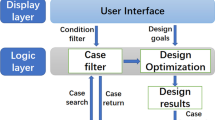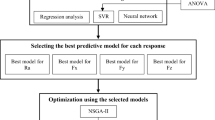Abstract
The main aim of this research work is to build a new practical hybrid regression model to predict the milling tool wear in a regular cut as well as entry cut and exit cut of a milling tool. The model was based on particle swarm optimization (PSO) in combination with support vector machines (SVMs). This optimization mechanism involved kernel parameter setting in the SVM training procedure, which significantly influences the regression accuracy. Bearing this in mind, a PSO-optimized SVM (PSO–SVM)-based model was successfully used here to predict the milling tool flank wear (output variable) as a function of the following input variables: the duration of experiment, depth of cut, feed, type of material, etc. The second aim is to determine the factors with the greatest bearing on the milling tool flank wear with a view to proposing milling machine’s improvements. Firstly, regression with optimal hyperparameters was performed and a determination coefficient of 0.95 was obtained. Secondly, the main advantages of this PSO–SVM-based model are its capacity to produce a simple, easy-to-interpret model; its ability to estimate the contributions of the input variables; and its computational efficiency. Finally, the main conclusions of this study are exposed.
Similar content being viewed by others
References
Rolt LTC (1965) A short history of machine tools. MIT, Cambridge
Hall H (2004) Milling: a complete course. Trans-Atlantic, New York
Bray S (2011) Milling. Crowood, Ramsbury
Schey JA (1977) Introduction to manufacturing processes. McGraw-Hill, New York
Goebel K (1966) Management of uncertainty in sensor validation, sensor fusion, and diagnosis of mechanical systems using soft computing techniques. Ph.D. Dissertation, Department of Mechanical Engineering, University of California at Berkeley
Agogino A, Goebel K (2007) BEST lab. In: UC Berkeley, Milling data set. NASA Ames Prognostics Data Repository. http://ti.arc.nasa.gov/project/prognostic-data-repository, NASA Ames Research Center, Moffett Field, CA
Cortes C, Vapnik V (1995) Support vector networks. Mach Learn 20:273–297
Vapnik V (1995) The nature of statistical learning theory. Springer, New York
Vapnik V (1998) Statistical learning theory. Wiley-Interscience, New York
Hansen T, Wang CJ (2005) Support vector based battery state of charge estimator. J Power Sources 141:351–358
Li X, Lord D, Zhang Y, Xie Y (2008) Predicting motor vehicle crashes using support vector machine models. Accident Anal Prev 40:1611–1618
Álvarez Antón JC, García Nieto PJ, Blanco Viejo C, Vilán Vilán JA (2013) Support vector machines used to estimate the battery state of charge. IEEE T Power Electr 28(12):5919–5926
Kecman V (2005) Support vector machines: an introduction. In: Wang L (ed) Support vector machines: theory and applications. Springer, Heidelberg, pp 1–48
Eberhart RC, Shi Y, Kennedy J (2001) Swarm intelligence. Morgan Kaufmann, San Francisco
Clerc M (2006) Particle swarm optimization. Wiley-ISTE, London
Olsson AE (2011) Particle swarm optimization: theory, techniques and applications. Nova Science, New York
Dorigo M, Stützle T (2004) Ant colony optimization. MIT, Cambridge
Panigrahi BK, Shi Y, Lim M-H (2011) Handbook of swarm intelligence: concepts, principles and applications. Springer, Berlin
Karaboga D, Basturk B (2007) A powerful and efficient algorithm for numerical function optimization: artificial bee colony (ABC) algorithm. J Global Optim 39(3):459–471
Karaboga D, Akay B (2009) A survey: algorithms simulating bee swarm intelligence. Artif Intell Rev 31(1):68–85
Karaboga D, Gorkemli B (2014) A quick artificial bee colony (qABC) algorithm and its performance on optimization problems. Appl Soft Comput 23:227–238
Simon D (2013) Evolutionary optimization algorithms. Wiley, New York
Yang X-S, Cui Z, Xiao R, Gandomi AH, Karamanoglu M (2013) Swarm intelligence and bio-inspired computation: theory and applications. Elsevier, London
García Nieto PJ, Martínez Torres J, Araújo Fernández M, Ordóñez Galán C (2012) Support vector machines and neural networks used to evaluate paper manufactured using Eucalyptus globulus. Appl Math Model 36:6137–45
Chen J-L, Li G-S, Wu S-J (2013) Assessing the potential of support vector machine for estimating daily solar radiation using sunshine duration. Energ Convers Manage 75:311–318
Zeng J, Qiao W (2013) Short-term solar power prediction using a support vector machine. Renew Energ 52:118–127
García Nieto PJ, Combarro EF, del Coz Díaz JJ, Montañés E (2013) A SVM-based regression model to study the air quality at local scale in Oviedo urban area (northern Spain): a case study. Applied Mathematics and Computation 219(17):8923–8937
García Nieto PJ, Alonso Fernández JR, de Cos Juez FJ, Sánchez Lasheras F, Díaz Muñiz C (2013) Hybrid modelling based on support vector regression with genetic algorithms in forecasting the cyanotoxins presence in the Trasona reservoir (northern Spain). Environ Res 122:1–10
Vilán Vilán JA, Alonso Fernández JR, García Nieto PJ, Sánchez Lasheras F, de Cos Juez FJ, Díaz Muñiz C (2013) Support vector machines and multilayer perceptron networks used to evaluate the cyanotoxins presence from experimental Cyanobacteria concentrations in the Trasona reservoir (northern Spain). Water Resour Manag 27(9):3457–3476
Essick J (2012) Hands-on introduction to LabVIEW for scientists and engineers. Oxford University Press, New York
Cristianini N, Shawe-Taylor J (2000) An introduction to support vector machines and other kernel-based learning methods. Cambridge University Press, New York
Furey TS, Cristianini N, Duffy N, Bednarski DW, Schummer M, Haussler D (2000) Support vector machine classification and validation of cancer tissue samples using microarray expression data. Bioinformatics 16:906–914
Guo G, Li SZ, Chan KL (2001) Support vector machines for face recognition. Image Vision Comput 19:631–638
Taboada J, Matías JM, Ordóñez C, García Nieto PJ (2007) Creating a quality map of a slate deposit using support vector machines. J Comput Appl Math 204(1):84–94
Fletcher T (2009) Support vector machines explained: Introductory course. University College London (UCL), London, pp 10–15, Technical internal report
Suárez Sánchez A, García Nieto PJ, Riesgo Fernández P, del Coz Díaz JJ, Iglesias-Rodríguez FJ (2011) Application of a SVM-based regression model to the air quality study at local scale in the Avilés urban area (Spain). Math Comput Model 54:1453–1466
Safavi HR, Esmikhani M (2013) Conjunctive use of surface water and groundwater: application of support vector machines (SVMs) and genetic algorithms. Water Resour Manag 27(7):2623–2644
Steinwart I, Christmann A (2008) Support vector machines. Springer, New York
de Cos Juez FJ, García Nieto PJ, Martínez Torres J, Taboada Castro J (2010) Analysis of lead times of metallic components in the aerospace industry through a supported vector machine model. Math Comput Model 52:1177–1184
Matías JM, Taboada J, Ordóñez C, García Nieto PJ (2007) Machine learning techniques applied to the determination of road suitability for the transportation of dangerous substances. J Hazard Mater 147:60–66
Schölkopf B, Smola AJ (2002) Learning with kernels: support vector machines, regularization, optimization and beyond. MIT, Cambridge
Shawe-Taylor J, Cristianini N (2004) Kernel methods for pattern analysis. Cambridge University Press, New York
Wasserman L (2003) All of statistics: a concise course in statistical inference. Springer, New York
Freedman D, Pisani R, Purves R (2007) Statistics. W.W. Norton & Company, New York
Picard R, Cook D (1984) Cross-validation of regression models. J Am Stat Assoc 79(387):575–583
Chang C-C, Lin C-J (2011) LIBSVM: a library for support vector machines. ACM T Int Syst Technol 2:1–27
Author information
Authors and Affiliations
Corresponding author
Rights and permissions
About this article
Cite this article
García-Nieto, P.J., García-Gonzalo, E., Vilán Vilán, J.A. et al. A new predictive model based on the PSO-optimized support vector machine approach for predicting the milling tool wear from milling runs experimental data. Int J Adv Manuf Technol 86, 769–780 (2016). https://doi.org/10.1007/s00170-015-8148-1
Received:
Accepted:
Published:
Issue Date:
DOI: https://doi.org/10.1007/s00170-015-8148-1




